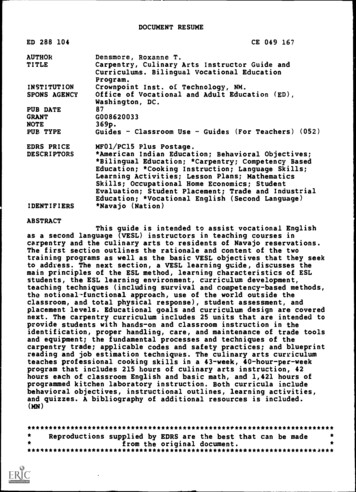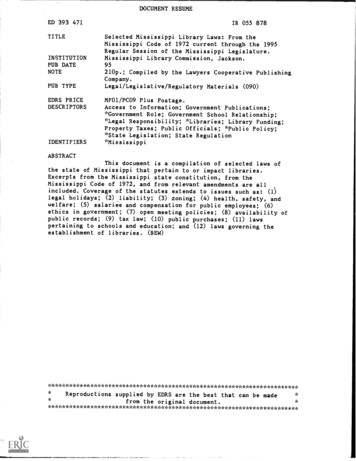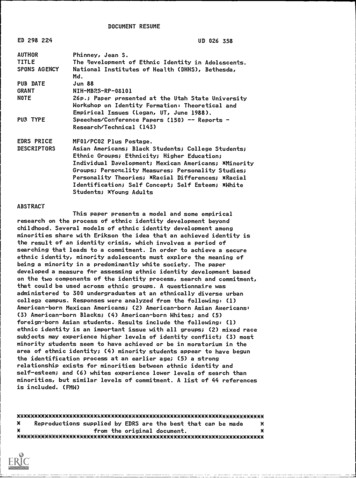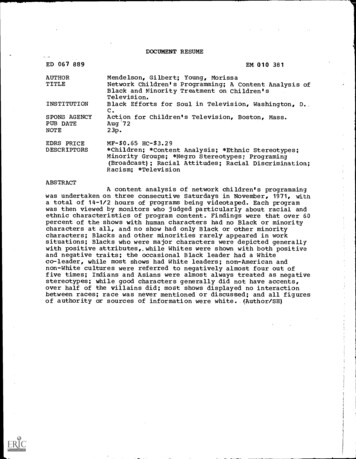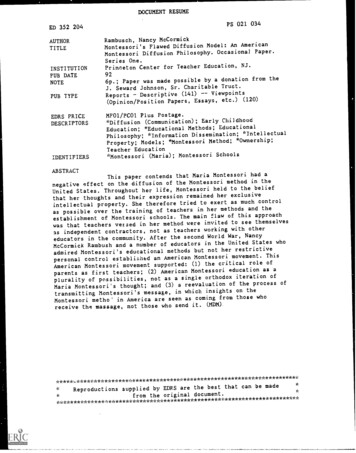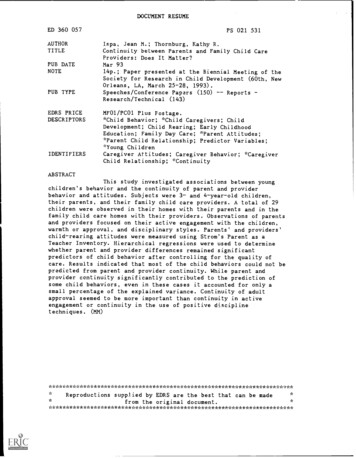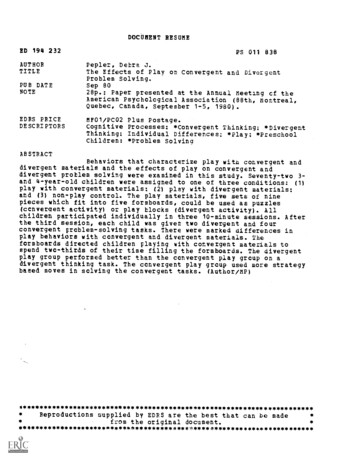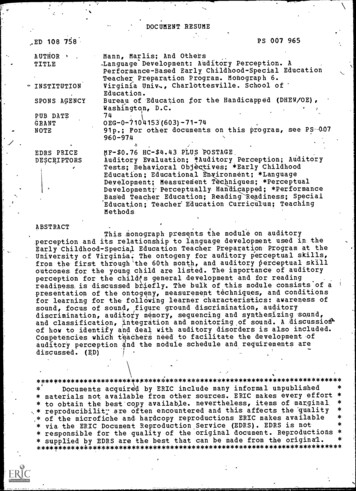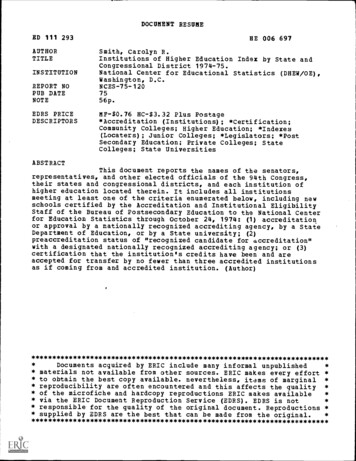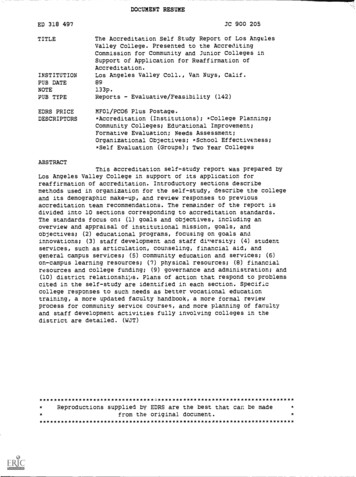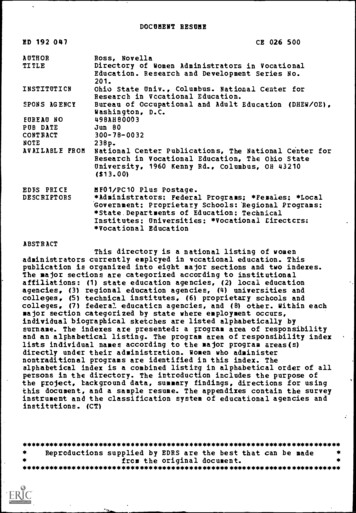
Transcription
DOCUMENT RESUMELI 001 929ED 039 002AUTHORTITLEINSTITUTIONREPORT NOPUB DATENOTESurace, Cecily J.The Displays of a Thesaurus.Rand Corp., Santa Monica, Calif.P-4331Mar 70EDRS PRICEDESCRIPTORSEDRS Price MF- 0.25 HC- 2.00*Computer Programs, *Indexes (Locaters)*Indexing,*Information Retrieval, Lexicography, *Thesauri*On Line SystemsIDENTIFIERS38p,,ABSTRACTWhat is the desirability and usefulness of differentthesaurus displays used either singly or in groups? Is analphabetical listing of terms with cross references more useful to anindexer than a complete hierarchical display? Is the permuted or therotated term index more useful to the indexer or retriever? Is analphabetical display along with a permuted display of more use thanan alphabetical display and hierarchical display? These are some ofthe questions raised and, at least, partially answered. The thesaurusdisplay techniques described include the kinds for: (1) hierarchy,(2) categorization, (3) permutation and (4) semantic and syntacticrelationships. Some intuitive discussion is given on displays whichappear to be of more utility to the indexer or the retriever.However, no actual tests of indexers using the same thesaurus indifferent displays, or studies of how indexers might supplement onedisplay with another were attempted. There is a brief discussion ofthe impact of the computer especially the assistance the computeroffers to file update and maintenance and the impact of on-lineterminals for display. (NH)
.tU,S, DEPARTMENT OF HEALTH, EDUCATION& WELFAREOFFICE OF EDUCATIONTHIS DOCUMENT HAS BEEN REPRODUCEDEXACTLY AS RECEIVED FROM THE PERSON ORIT, POINTS OFORGANIZATION ORIGINATINGSTATED DO NOT NECESVIEW OR OPINIONSOFFICIAL OFFICE OF EDU.SARILY REPRESENTCATION POSITION OR POLICY5550THE DISPLAYS OF A THESAURUSISssDCecily J. SuraceMarch 1970cI,5,V5ii: t45t5k'/5-,,4t 5wI1k.1., 1',k,,',,,,'.5vtfi5, .1:,,I,,At,'5,5,"5 J't'.1,-,,',- '-'.".,-,;"
THE DISPLAYS OF A THESAURUSCecily J. Surace*The Rand Corporation, Santa Monica, CaliforniaA great deal of literature exists on the development or construction ofa subject authority file or thesaurus, including the importance of vocabularycontrol techniques.Very little exists in the literature however, on the bestway to display the authority file or thesaurus for efficient and consistent useby the indexer and the retriever.Even less information is available on thedesirability and usefulness of different displays either singly or in groups.For example, is an alphabetical listing of terms with cross references moreuseful to an indexer than a complete hierarchical display?the permuted or rotated term index serve?or retriever?IsWhat value doesit more useful to the indexerTo the experienced or inexperienced indexer?Is an alpha-betical display along with a permuted display of greater utility than analphabetical display and a hierarchical display?Questions of this natureare very relevant to a system designer concerned with the construction orautomation of a thesaurus where cost is a great factor.It is estimated thata thesaurus maintenance program wi I I cost between 50, 000 - 75,000 todesign and code; some programs are available for sale at 15,000.Consideringthese costs, it is difficult to understand why thesauri continue to be developedand constructed with so little recorded study of alternative displays.It isalso difficult to understand why studies on indexing consistency and effectiveness have not concerned themselves with studying the effect different displays*Any views expressed in this paper are those of the author. Theyshould not be interpreted as reflecting the views of The Rand Corporationor the official opinion or policy of any of its governmental or privateresearch sponsors. Papers are reproduced by The Rand Corporation as acourtesy-to members of its staff.
of a thesaurus may have on the indexer.Instead these studies generallyconcern themselves with -,omparisons of different kinds of authority files,assuming the organizations using these files have the same objectives, orelse concern themselves with indexer consistency in terms of experience vsnon-experience.This paper will attempt to describe several dispky techniques for athesaurus, including the kinds of displays ior hierarchy, categorization, permutation, and semantic and syntactic relationships. Where possible someintuitive discussion will be included on displays which appear to be of moreutility to the indexer or the retriever. No attempt was made to perform actualtests of indexers using the same thesaurus in different displays, nor was theretime to determine how indexers might supplement one display with another.1Instead, this paper may be categorized as one which raises some questions butwhich is not successful in answering them, or else only partially successful.Included also in this paper will be a brief discuss'on of the impact of thecomputer especially in terms of the assistance the computer offers to file updateand maintenance, and the impact of on-line terminals for display.Thesaurus DefinitionsMany definitions exist for a thesaurus:"A thesaurus is an authority file which can lead the user from oneconcept to another via various heuristic or intuitive paths. It maybe manually operated or mechanized for assignment of index headings."P. W. Howerton (in Newman, 1965).consists of a standardized, controlledvocabulary, with cross-references between the terms of thevocabulary and cross-references to terms of the vocabulary.It consists of either a controlled vocabulary or a set of crossreferences, or both."P. Reisner (in Newman, 1965)"An authority fileOnly one paper was found in the literature which concerned itself withthe use indexers made of different displays of a thesaurus. This was a paper byRainey (1970) which surveyed 75 special libraries to determine how they usedthe NASA and EJC/DOD thesauri, and which included a question on whetherindexers used the special indexes.1
"A thesaurus is a device for controlling and displaying anindexing vocabulary."T. L. Gillum (1964)"An organized reference of the terms accepted and approvedas a standard by participating members of a specializedpopulation in a defined area of information, which identifiesthe scope of each term by inclusions, exclusions and associations,the aggregateso that all terms are clear and discrete and inare comprehensive for communication and identification ofinformation in the defined area."P. C. Daniels (1969)thesaurus is a list ofIn summary, another definition is offered: Aauthorized terms or descriptors which serve to standardize and delimit condisplayed revealcepts found in publications, and which when structured andrelationships of a semantic, syntactic or hierarchical nature.The type of thesaurus of primary interest to this paper is best representedby the EJC-DOD thesaurus.principles for aEugene Wall (1969) suggests that there are four basicthe use of natural language; an environment which permits theaddition of new terminology; cross references including semantic and hierthesaurus:archical viewpoints; and what he refers to as "form and format," furthershoulddefined as "ease of use." There is no indication that the thesaurusbe displayed in more than one form or format although Mr. Wall hasthesaurus can becertainly contributed significantly to the various ways areallydisplayed. In fact, most discussions of thesaurus displays arediscussions of the techniques used to reveal the semantic, syntactic andhierarchical structure of cross references embodied in an alphabetical listof terms.Indeed the application of these control techniques results in adisplay, but this is perhaps more an effect or result of the techniques,rather than the starting point of the thesaurus construction.chicken and egg syndrome?Or is this thePerhaps this is because today's thesaurus buildersand are not concernedare operating in a coordinate indexing environmentheadings or their display.with more fundamental issues of the form of
Since natural language is used and in most cases single words (althoughsome pre-coordinated terms are used) the philosophical discussions of directheadings vs indirect headings or classification are almost non-existent.However, is this really so?Or are today's. thesauri with their increaseduse of auxiliary displays to reveal hierarchical schemes, category listings,and permuted listings intended to provide the best of all worlds neverresolved by the battles which raged in the above mentioned philosophicaldiscussions?While the economics of building alternative displays formanually controlled thesauri have conditioned us to accept a single display,and that the alphabetical term display, the computer-managed or automatedthesaurus on the other hand, has made alternative displays economicallyfeasible, and as a resuit offers an opportunity to the thesaurus designer toconsider new formats.It is suggested that more study and analysis ofalternative displays is essential fora more complete understanding of therole the thesaurus plays in indexing and retrieval operations.It isalso recognized that no discussion of thesaurus displays can avoid discussionof control technique:;.Control TechniquesIncluded in control techniques are term selection, the use ofabbreviations and acronyms, use of nouns or other forms, singular vs plural,and alphabetization.for semantemes:Additional control techniques include cross referencessynonyms, homographs, antonyms, generics, port-whole,related terms, and scope notes and parenthetical expressions to avoidambiguity.Alphabetical DisplayThe alphabetical display of thesaurus terms is the most common formof display, influenced historically by the conventional alphabetical displayof indexes and subject heading authority files.In its simplest form thealphabetical display or dictionary display consists of a list of terms or
-5-descriptors in natural language order without cross references.Obviouslythis display is very limited and offers little assistance to the indexer orretriever, unless the list of terms is very small and a ,quick glance revealsall the terms. No network or cross references are present to help the userweave his way to a more specific or more generic level, etc. Coates(1960) refers to this display as the alphabetico-specific subject catalogue.Inits most common form it does include "see" and "see also" cross references,and attempts to provide through these conventions control over synonyms, classand related terms thereby offering some classification scheme.Most modern day thesauri are not limited to a simple alphabeticaldisplay of terms, but rather incorporate the more complex cross referencescheme found in the more sophisticated alphabetico-specific subject authorityfiles.The notation used may be different however.Instead of "See" and"See also" with X and XX as reciprocals, the notation in current vogue is"See" and "Used for," and "RT" representing related term. "RT" is alsoused as a reciprocal to "RT."And of course some hierarchy is included inthe use of "NT" (narrower term) and "BT" (broader term) notations.The thesaurus or subject heading authority file which limits itself tothe alphabetico-specific display does not provide the user with a completegeneric structure however.The classification scheme built into the thesaurusby use of "See" and "RT" cross references is rather limited and the usermay have to refer to several terms before arriving at the desired term orterms.This is a gross over-simplication of the problems associated with thealphabetico-specific display.The reader is referred to Coates (1960) andothers for more complete discussions.An alternative approach to resolve the dictionary display problems isthe use of an alphabetico-classed display. This authority file is based onan alphabetical display of terms with the use of subdivisions to reveal genericrelationships.For example:
-6-AircraftAircraftAircraft - BombersAircraft - FightersAircraft - SupersonicAircraft - TransportBombersFightersSupersonicTransportinstead of:orAircraft see also Bombers, Fighters, etc.This form of display is helpful to the indexer because it reveals at aglance the related terms. Howe Ver, the indexer or retriever may not knowwhich is the main class term - Aircraft, or Fighter Aircraft, or CommercialAircraft, etc.Thus "see" references are required throughout the classeddisplay, increasing the size of the file.An alternative is to provide a seconddisplay which is an alphabetical index to the classed file indicating themain or class terms.However this results in a two-step operation and doublefile maintenance.The alphabetico-classed file also raises the issue of what constitutes amain or class term, and what is subsumed under it, and how specific thesubsumed terms should be.In addition, a term can belong to more than oneclass.The modern day thesaurus generally does not attempt to provide aclassed thesaurus as the main display.Instead a partial hierarchical displayis interwoven in the cross references of the main alphabetical display, andseparate hierarchical and category or class displays are provided as auxiliarytools.Another approach to provide an organic structure to the authority fileis the use of inverted headings.This form of display is based on the premisethat in multiword subject headings there is one term that is more important,and this is the term the indexer and retriever will use. Also in selectingthese "key" words, and listing terms by their key word, a natural classstructure is provided.Thus for example:AirplanesAirplanes, CommercialAirplanes, FighterAirplanes, Transport
Where necessary, cross references are provided from the natural languagetext to the inverted entry.Although inverted headings are not used in very many modern daythesauri,it is fairly safe to conclude that the complex cross referencestructures prevalent today are an attempt to reveal some of the relationshipsthat' the inverted headings accomplished.But, is it as safe to conjectur
The thesaurus display techniques described include the kinds for: (1) hierarchy, (2) categorization, (3) permutation and (4) semantic and syntactic relationships. Some intuitive discussion is given on displays which appear to be of more utility to the indexer or the retriever. However, no actual tests of indexers using the same thesaurus in
![Fear Nothing [039 5.0] By Dean R. Koontz](/img/5/fearnothing.jpg)
